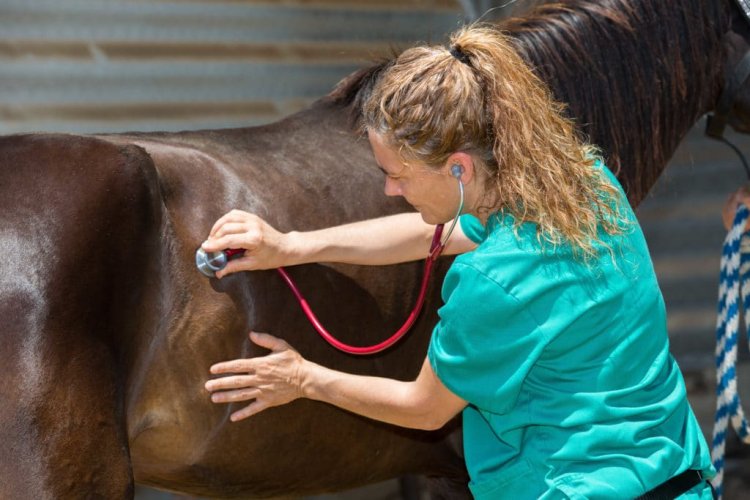in basket
TOP OFFER - SUMMER20 - 20% OFF* and 4 FREE seasonal products! *Excludes smaller pack sizes, treats, feed and mash.
Tying-up in horses

What is tying-up?
The term "tying-up" in horses is used to describe a variety of muscle disorders in horses. Other terms used for this syndrome include Exertional Rhabdomyolysis, ‘Monday Morning Disease’ and Azoturia. The clinical signs observed when a horse encounters an episode of tying-up are varied and very much dependent on how severe the episode is. For example, in mild cases, the horse may appear stiff after exercise, but at the other end of the scale the affected horse may exhibit signs of intense pain, reluctance to move and inability to stand and bear weight. When exercised, a horse that is tying-up can often present as reluctant to move and might have an unusual way of standing that may look like they are about to urinate.
It is generally the muscles in the hindquarters that are most affected and this area of the horse will likely be firm and painful to touch; cramping may also be seen when the muscles are palpated. The horse may be showing signs of sweating and on examination can have an elevated heart and respiratory rate. In very severe cases, horses may pass dark, red-brown coloured urine, which is known as myoglobinuria. The discoloration of the urine is due to the presence of a muscle protein called myoglobin. The pain can persist for several hours following the onset of an episode of tying-up.
To diagnose an episode of tying-up your veterinarian can take blood from your horse and examine the serum activities of creatine kinase (CK) and aspartate aminotransferase (AST). CK and AST are proteins contained within muscle cells and are realised into the circulation when cells are damaged. The levels of CK in the blood increase rapidly during a tying-up episode with the highest values occurring four to six hours after onset. AST values increase and decrease much more slowly than CK and may even remain elevated for ten days after an episode.
It is important not to confuse tying-up with muscle strain and soreness. Similar to humans who may over exert themselves for their current level of fitness, horses can also strain a muscle or experience muscle soreness if the level of work they are undertaking is higher than their current fitness supports or if there is an inadequate warm up.
Causes of tying-up
The causes of tying-up are not still completely understood. However, based on what is currently know about this condition there appears to be two types of tying-up; 1) sporadic, whereby a horse experiences an episode of tying-up on a rare occasion, and 2) chronic, where a horse is having repeated episodes of tying-up with the first episode occurring at a young age. The most common cause of sporadic tying-up seems to be related to the horse’s underlying training, for example when a horse is asked to compete with minimal training and low level of fitness.
The chronic type of tying-up is often more problematic for trainers and veterinarians to manage. Repeated episodes of tying-up impacts on competition preparation and can significantly restrict the horse’s athletic career. Research has identified two specific causes of tying up: 1) Recurrent Exertional Rhabdomyolysis (RER) and 2) Polysaccharide Storage Myopathy (PSSM). RER is a condition where there is a deficit in the mechanism of muscle contraction and PSSM is a disorder that results in excess storage of glycogen (a simple carbohydrate) and an abnormal form of polysaccharide (a complex carbohydrate) in muscle. There is evidence that, in some horses, electrolyte imbalances can be an important factor in the development of tying-up.
Management of chronic tying-up
There is no cure for chronic tying-up, the aim is to implement a management and feeding programme that reduces or eliminates episodes of tying-up.
Regular exercise is important in horses that are prone to tying-up, this should be daily and either by turnout (if the horse is unable to be ridden) and/or by riding or lunging. Regular exercise has shown to be extremely beneficial in reducing muscle damage. Periods of box rest of more than two days should be avoided, particularly in horses that are very fit. Also, days with no exercise should be minimum and try to avoid two days of no ridden exercise in a row. Periods of stress have also been linked with episodes of tying-up and therefore management practices should aim to minimise stress by ensuring the horse is not completely isolated from other horses, making any changes to the diet or management gradually.
Dietary management of chronic tying-up
Dietary management is very important. The diet of horses with this condition should be evaluated with a focus around ensuring that the diet is low in non-structural carbohydrates (NSC). NSC includes starch and water soluble carbohydrates (WSC). WSC includes fructan and simple sugars. Fresh (pasture) and conserved (hay and haylage) grass can contain significant amounts of WSC and it is advised that horses that are prone to tying-up are fed a forage containing less than 12 % WSC. It is advisable to have your forage source tested for WSC content and if more than 12 % then soaking to reduce the WSC content is advisable. If the hay has a high NSC content, then soaking should be done by submerging the forage in water for 3 hours (or more). It may be beneficial to have the forage analysed for WSC content both before and after soaking as the amount of WSC lost during soaking is variable and dependent on a multitude of factors.
However, the diet must contain adequate amounts of fibre (forage) and as a very minimum a horse should eat 1% of their bodyweight in forage each day (on a dry matter basis). Therefore, in a 500 kg horse this is 5 kg of dry matter, which means the amount of the forage not including the water content. In hay the dry mater content is generally around 85 %, in haylage this drops to between 50 and 70 %, and in pasture this may only be in the region of 20 %. For example, 5 kg dry matter of hay at 85 % dry matter is 5.9 kg fresh weight (the actual amount fed). If the hay is being soaked then it should be weighed prior to soaking.
As pasture can also contain significant amounts of WSC, affected horses should not be turned out on lush pasture. Care must also be taken during times of the year when WSC content of pasture is likely to be higher. However, horses prone to tying-up benefit from exercise and turnout at pasture is beneficial in that respect. Therefore, it may be worth considering the use of a grazing muzzle in the spring/summer months to limit WSC intake. Furthermore, turnout is best during the hours of darkness if possible as the WSC content of the grass is usually lower. A broad spectrum vitamin and mineral supplement is recommended for horses on limited pasture and receiving soaked hay. Also, as some cases of tying-up may be due to electrolyte imbalances it is important that sufficient amounts of electrolytes are provided in the diet (please refer to previous article on electrolytes). The diet may also require additional vitamin E and/or selenium.
It has been known for many years that feeds high in starch, such as cereal grains or compound mixes containing cereal grains, are not recommended for horses prone to tying-up. If additional energy is needed in the diet to meet the energy requirements for work, then feeds high in fibre are beneficial. For example, alfalfa and sugar beet pulp (unmolassed), which are high in energy and low in starch. If further energy is required then vegetable oil can be added to the ration. High fibre feeds and oil are ideal feeds for horses prone to tying-up. Adding a small amount of vegetable oil to the diet of horses prone to tying-up has been shown to diminish the clinical signs associated with this condition. It would be beneficial to feed an oil with good levels of omega-3, such as hemp oil or linseed oil. This can be fed at between 100 to 500 ml per day depending on energy requirements. Oil should be introduced gradually over a period of 2 to 3 weeks and the amount fed should be reduced or stopped if the horse begins to gain excess weight. If high levels of oil are fed then it is advisable to supplement the diet with vitamin E.
Studies have also shown that supplementing the diet with a good quality protein supplement can be beneficial for horses prone to tying-up. Branched chain amino acids (BCAA) such as leucine, isoleucine and valine have been seen to support the reduction of muscle breakdown in human athletes and aid the recovery process after exercise. As such, BCAAs are also considered to be a beneficial addition to the diet of horses prone to tying-up.
Summary
In conclusion, chronic tying-up cannot be cured, but can potentially be prevented through good management and feeding practices. The dietary management of horses prone to tying-up should be as follows:
- Adequate low NSC forage provision
- High fibre feeds
Low NSC feeds - Adequate electrolyte provision
- Vegetable oil if additional energy is required
- Additional Vitamin E and/or selenium (if required)
- A good quality protein supplement
Article written for Premier Performance by Professor Jo-Anne Murray.








